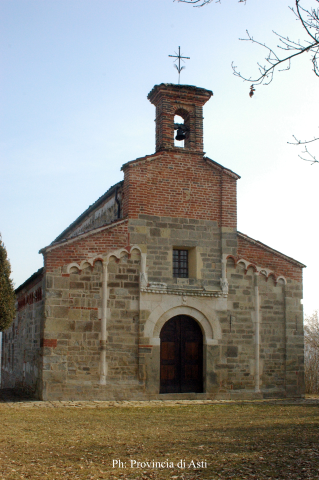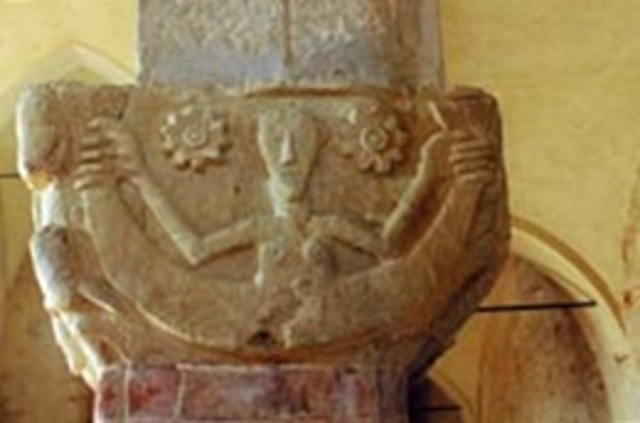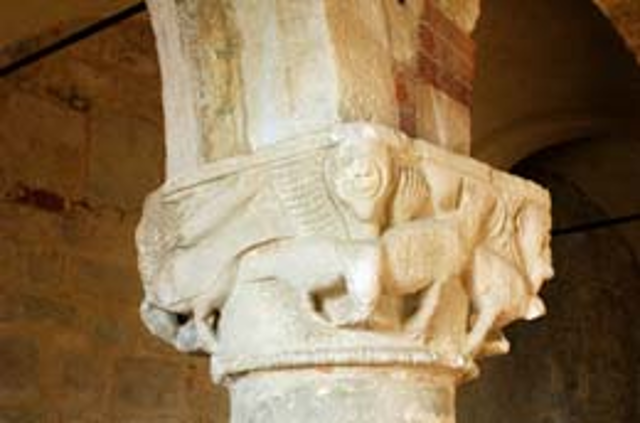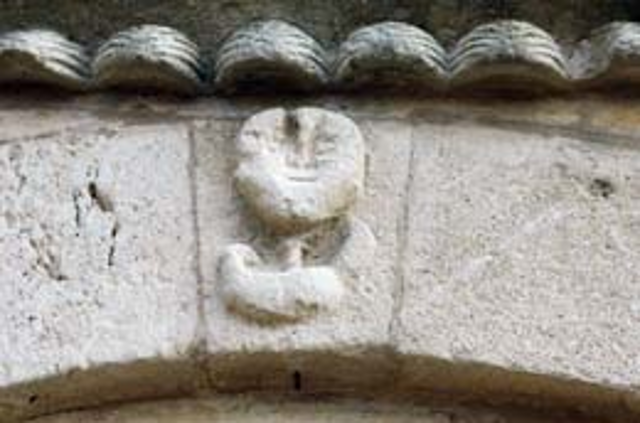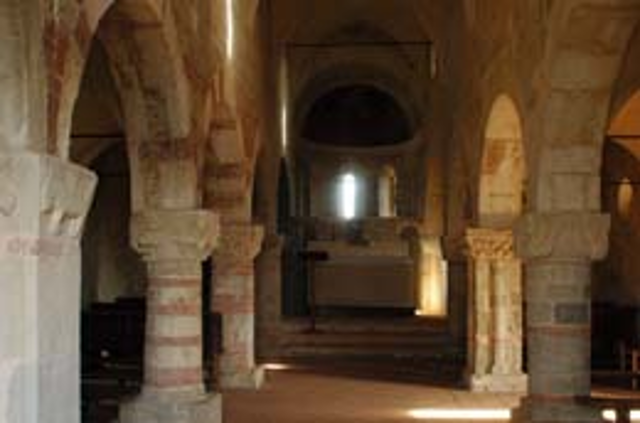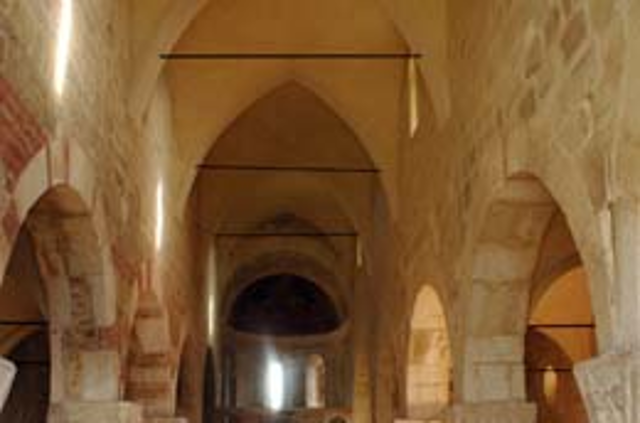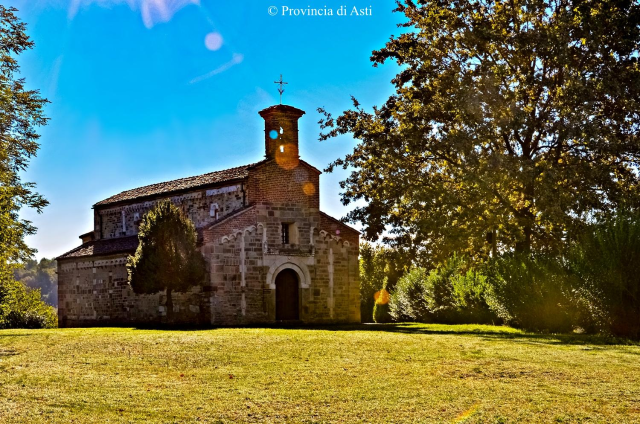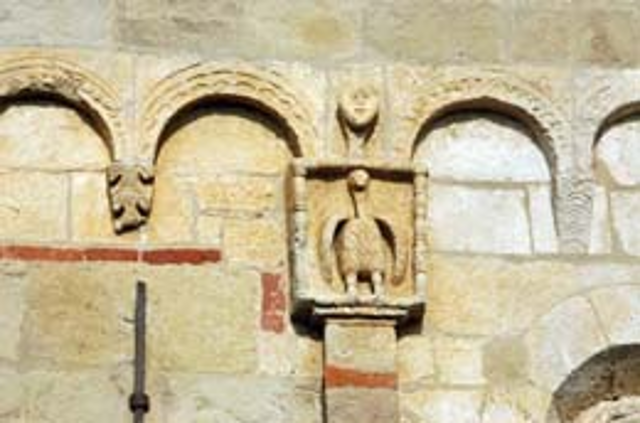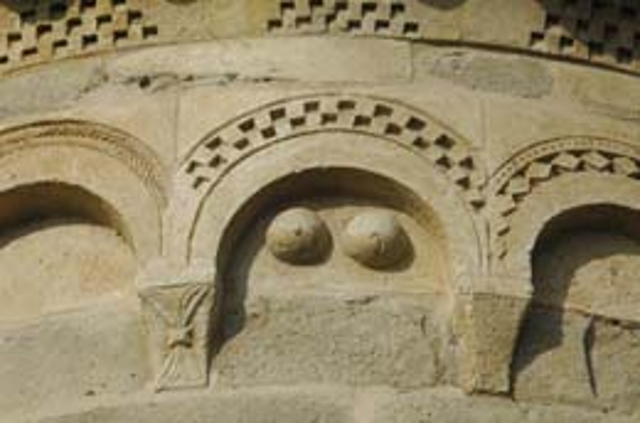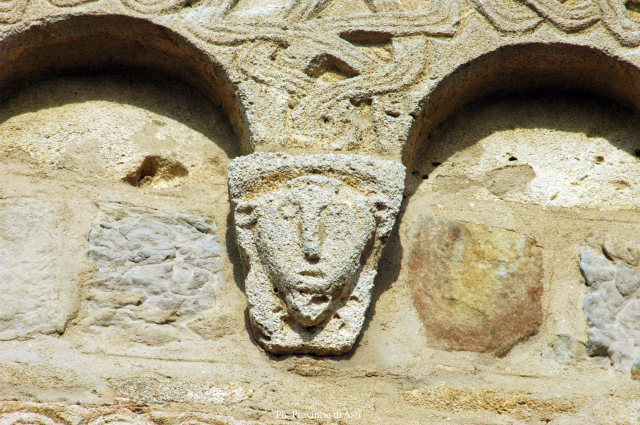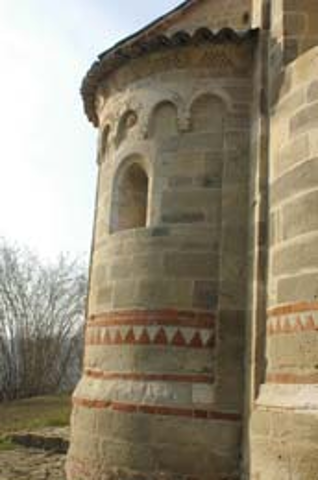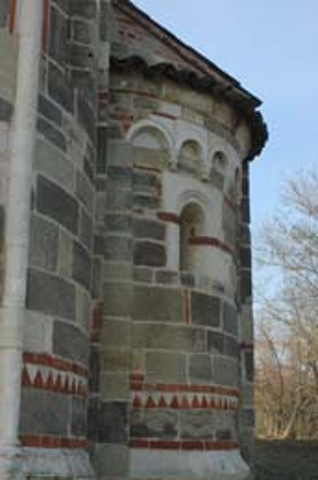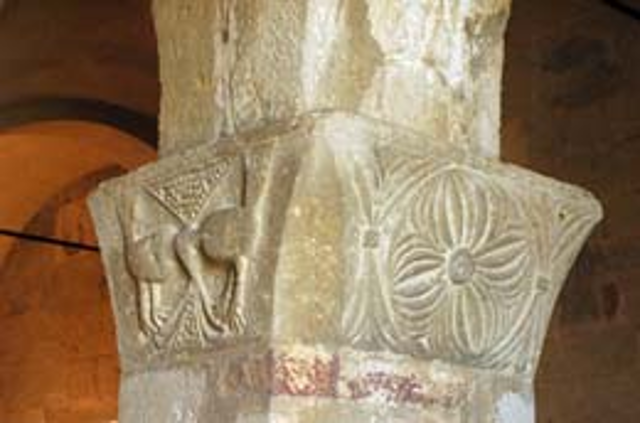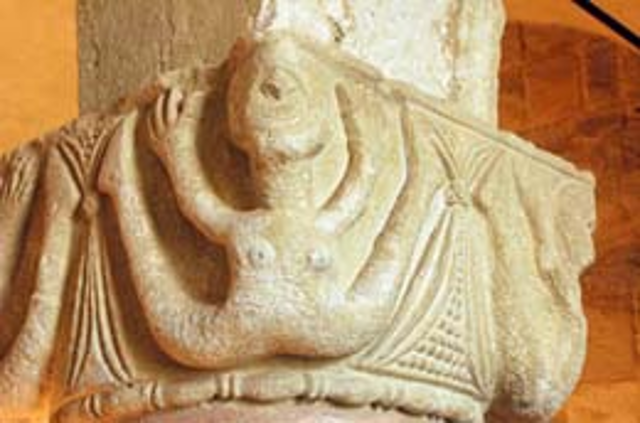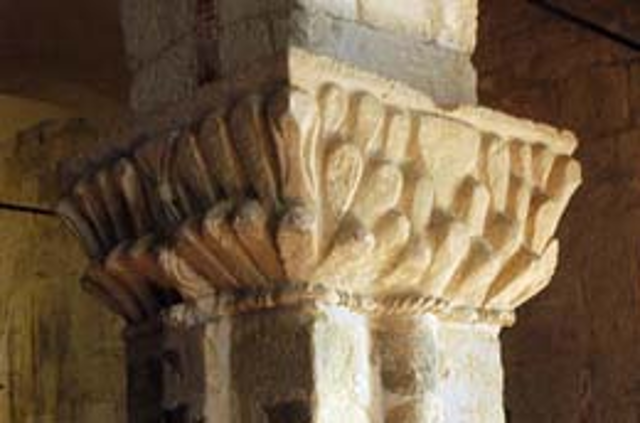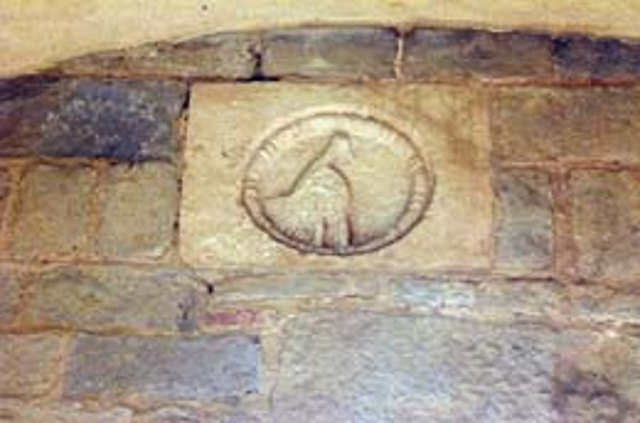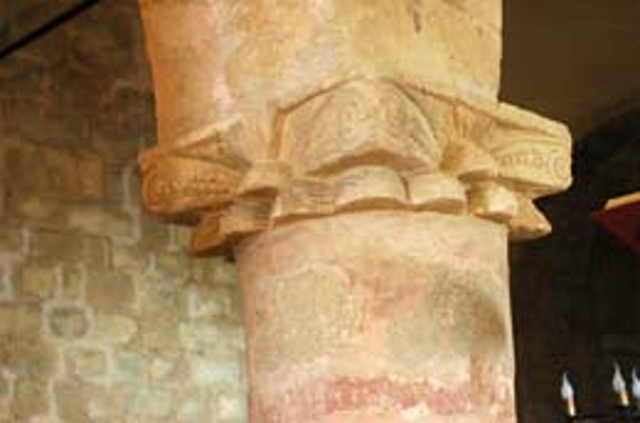Church of St. Secundus (Chiesa di San Secondo) | Locality of Mongiglietto
Highlights
On a hill in front of the town stands the ancient 12th-century church of St. Secundus, well preserved in its primitive forms.
The west-facing facade, with a single central portal, is clad largely in sandstone; it has decorations in which zoomorphic, phytomorphic but also anthropomorphic figures appear.
The interior, characterized by pointed vaults, has three naves, separated by columns with round and square sections and richly carved capitals.
The central apse holds a 14th-century fresco depicting Christ between two saints.
The Romanesque church of St. Secundus in Mongiglietto
The part of the province of Asti north of the Tanaro river is dotted with numerous medieval architectural testimonies, found mainly in religious buildings.
Once these churches were "pievanie" or simple parish churches with a cemetery around them. Some time ago some settlements moved to other hills, and the old churches almost always remained in the center of the cemetery to continue their function of inviting the living to pray in union with that of their "elders" now living in the Lord.
This is the church of St. Secundus in Cortazzone, even if the ancient cemetery, which was around it, no longer exists.
In the Astigiano, it is the most interesting already parish church of medieval layout, with the façade rendered characteristic by the seventeenth-century additions.
It is a small ornate casket containing the typical medieval sculptures, found on the route of the Via Francigena.
Arch. Quaglia Fr. Alessandro
Diocesan Section Management
Note: original text written in Italian
The environment
The Romanesque church of St. Secundus stands on the hill of Mongiglietto, 241 meters above sea level and about one km from the town of Cortazzone.
It can be seen after a sharp turn to the left, at the bottom of a vast grassy clearing, inserted almost majestically into the landscape, at the center of a magnificent crown of green hills, oriented East-West.
Mongiglietto, probably from the Latin Mons Jovis: mount of Jupiter, as the site of a pre-existing pagan temple; or Mons Jubili, mount of joy; Mont-joie - mongioia! - In ancient French, a pile of stones to indicate the way or in memory of important events.
The building
Basilica plan with three naves; each ending in a semicircular apse, it is built of locally sourced materials. The masonry is mainly made of blocks of exposed stone, with the insertion of rows of bricks.
It has external measures of 19.50 meters in length and 8.60 meters in width; height at the top of the roof 8.25 meters. The interior has a length of 18 meters and a width of 7.25 meters.
The facade
The masonry is mostly in blocks of stone, then rises in the central part with a brick wall, at the top of which there is a small bell tower, built in the seventeenth century and equipped with a bell to attract the faithful.
Entrance has a double stone arch, bordered above by a horizontal frame of shells, which would indicate St. Secundus as a church on the way of great pilgrimages.
Walnut door, dating back to the middle of the 19th century, was restored in 1992.
Agile half-columns divide the side parts of the façade and continue, alternating with half-pilaster strips, around the perimeter, dividing the building into spans of different widths.
On the capitals are set the small arches that crown the masonry. Under some of the small arches, on either side of the shell frame and in the center of the stone arch, early zoomorphic and anthropomorphic sculptures can be admired.
The grated window was opened in an undated period.
North side
It is rather unadorned, except for the hanging arches of the crown.
There are three single-lancet windows in the raised part of the nave; two are closed from the inside, with sparse decorative elements.
The apses
The apse area is rich in geometric elements in the crowning, especially that of the central apse and the south apside, with the high decorative bands, the leafy carvings of the capitals on the semi-columns and rectangular pilasters, and the variety of the corbels on which the hanging arches rest.
Interesting sculptures also in the intrados of the small arches.
These include a human figure in the act of clinging to one of them.
The side apses each have a single window while the central one has three; the one facing East retains part of the original terracotta closing grating.
In the lower part all three apses have a "wolf's teeth" band in terracotta, which continues for a stretch in the masonry of the south wall.
South side
This side deserves particular attention due to the richness of the sculptural decoration, especially in the upper part of the nave with the high band of interlacing, friezes, foliage and tendrils now interrupted now resumed; and then figures, carved capitals, and cordonatures crowning the three fine single-light windows.
In the lower part the "damier" crowning, more capitals and small arches carved with foliage, a cross, human heads, animals and the beautiful eagle in a square frame above a pillar, and more in an inexhaustible imagination.
Halfway up the side is a door from which one enters the interior, coeval with the front door, also made of walnut, restored in 1992.
Above the door are a lunette and an arch, itself framed by "sawtooth" bricks. Two single-lancet windows and an oculus, give light to the lower part of the building.
In the third span of the upper part, above the small arches, a singular carving which, according to the study of Piero Leonardi (1984), in its primitiveness is intended to refer to a mating scene,something uncommon in church ornamentation, and would find explanation in local prehistoric traditions.
Some interpret the carving and other signs of fertility such as breasts, propitiatory for the birth of children and for an abundance of milk to feed them, or as an ex voto in case of a difficult birth.
The interior
The austere three-aisle interior is divided into five bays by alternating columns and pillars, with carved capitals, on which the arches are set.
The ribbed vaults, "in place of the ruined ceilings, with arches distributed according to the old arches," the terracotta tile floor, raised in the chancel by three steps, the changes to the 'masonry altar with the side arches, are from the middle of the last century, as shown by the "appraisal of calculation, for the urgent repair to be made around the 'very ancient building of the Church of St. Secundus located on the ends of Cortazone”. Survey done by Chief Master Mason Giovanni Gobbi of "Cortazone," July 14, 1843, which was followed by a Report on the execution of the work, by Surveyor Giovanni Santanera of Villafranca, February 24, 1853 (parish arch.).
The three apses have semi-fold vaults. In the central one, underlined by a “damier” frame, there is a fresco from the 14th century.
The capitals
For the particular sculptural decoration, the capitals on the columns and on the pillars, deserve to be examined one by one, even if the symbolism of the subjects is not easy to interpret. The symbols could be allusive to vices and virtues and wanted to induce the pilgrim to settle inwardly.
Examples
The mermaid; symbol of the allure and ambiguity of temptation. The circle: symbol of perfection and eternity. The hare: negatively, refers to her great sensuality that leads her to extreme fecundity; positively, the speed of her running could allude to the brevity of human life, etc.
Pillar - It has rounded corners and the capital is carved on three sides. In the center two birds pecking seem to have only one head. On the side is a large flower; on the opposite side is a cross.
Column - the capital has four mermaids as a corner figure, spanning the four sides, with spread arms and tail, stretched upward. (Romanesque mermaid or fish woman with tail in both hands - H. Focillon).
Pillar - on opposite sides, two semi-columns and two pillars.
The capital is completely surrounded by large petals, sometimes interpreted as “inverted ovules” or petals of chrysanthemum, symbol of infinity.
Column - next to the chancel steps. Has a square capital without sculpture. This capital, like the other two on the half-columns at the side of the altar, can also be seen as purposely unfinished, as a sign and warning of human non-perfection, a perfection that is God's alone.
Above the side door a peacock in the round.
Column - on the other side of the nave, capital with shells and decorative volutes.
Pillar - Has slender terracotta columns that round its corners. The capital presents, in apparent disorder zoomorphic and anthropomorphic figures.
On the side facing the altar is a mermaid with her tail spread out in an arc "held with both hands." She has nicely incised hair, tail, and fins; on the sides of her head, two flowers. On the opposite side, evidently incomplete, appears a kind of two-headed monster, its front legs resting on a human head, which seems to act as a capital to the corner column.
One head bites its tail and the other, maned, turns toward the corner to form the large head of a harnessed horse, which crosses its tail with that of a twin horse that turns its head to the opposite corner. At the bottom is a bovine head turned upward, biting a leg of the horse. On the fourth side, almost to lighten the whole, flowers and foliage.
Column - At the corners of the capital, a single head for the body of two birds, which are developed on the sides with crossed tails. Above the heads of the birds: anthropomorphic figures; at the side of one of them, a right hand.
Pillar with rounded corners. On two sides of the capital, a large hare (or rabbit), two fish on another side, a flower and palm branches on the fourth side.
To retrieve the church access key, contact:
• Ristorante Pizzeria il Puffo
Insights
Associazione InCollina, Turismo nel cuore del Piemonte
https://www.turismoincollina.it
- San Secondo, Cortazzone
https://www.turismoincollina.it/scopri/chiese-romaniche-tra-po-e-monferrato/san-secondo-di-cortazzone-monferrato/
BeWeb - Beni Ecclesiastici in WEB
https://beweb.chiesacattolica.it/
- Chiesa di San Secondo
https://www.beweb.chiesacattolica.it/edificidiculto/edificio/62493/Chiesa+di+San+Secondo
Wikipedia, l'enciclopedia libera.
https://it.wikipedia.org
- Chiesa di San Secondo (Cortazzone, Mongiglietto)
https://it.wikipedia.org/wiki/Chiesa_di_San_Secondo_(Cortazzone,_Mongiglietto)
GAL BMA - Gruppo di Azione Locale del Basso Monferrato Astigiano
https://www.monferratoastigiano.it/
- Comune di Cortazzone (AT)
https://www.monferratoastigiano.it/comune-di-cortazzone-at/
GAL BMA - Gruppo di Azione Locale del Basso Monferrato Astigiano
https://www.monferratoastigiano.it/
- Comune di Cortazzone (AT)
https://www.monferratoastigiano.it/comune-di-cortazzone-at/

